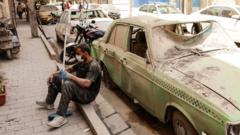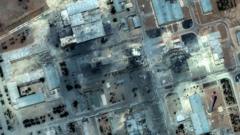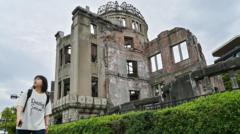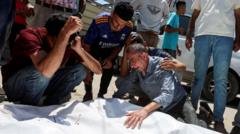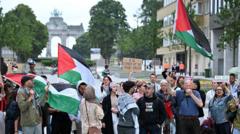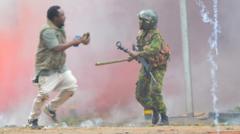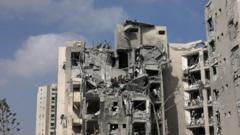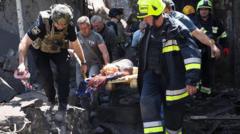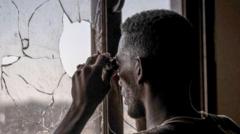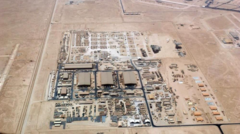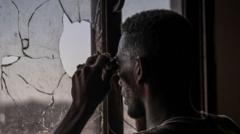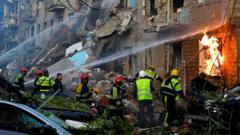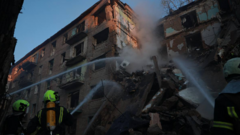The aftermath of a 7.7 magnitude earthquake in Mandalay, Myanmar, has revealed extensive destruction, with many individuals trapped or missing. Rescue and relief efforts are hampered by the country's political turmoil, leaving survivors in dire conditions and insufficient aid.
Catastrophic Impact of Myanmar Earthquake Leaves Survivors Desperate for Aid
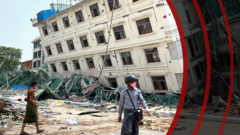
Catastrophic Impact of Myanmar Earthquake Leaves Survivors Desperate for Aid
A recent earthquake in Myanmar has resulted in widespread devastation, with countless families struggling for survival amidst inadequate relief efforts.
Mandalay, Myanmar – As alarming scenes of destruction unfold in the aftermath of a catastrophic earthquake that struck last Friday, communities find themselves grappling with immense loss and uncertainty. The 7.7 magnitude earthquake brought down numerous buildings, particularly in northern and central Mandalay, where streets are lined with rubble and unstable structures. The fallout from this disaster reveals a grim reality for those affected as they await assistance, which has mostly not yet materialized.
Entering Mandalay, the sheer scale of devastation grows clearer with every corner turned. Collapsed buildings are numerous, and most visible structures bear cracks that render them unsafe for entry. In the face of such overwhelming calamity, local hospitals have been forced to provide care in outdoor settings due to damage sustained during the quake.
The ruling military government in Myanmar has barred foreign journalists from accessing the area, limiting the documentation of the disaster's effects. Risking potential repercussions, our team operated undercover to report on the dire circumstances faced by residents and the lack of immediate help.
Among those waiting for news are families like that of 41-year-old Nan Sin Hein, who spends her days watching a collapsed building where her 21-year-old son, Sai Han Pha, is presumed missing. As a construction worker involved in renovation, he was among several trapped when the structure buckled precariously. "If they can rescue him today, there’s a chance he’ll survive," she expressed, holding on to the faint hope that her son is alive beneath the rubble.
The political instability in Myanmar complicates rescue efforts. The military has been in conflict with insurgent groups, diverting resources and personnel away from relief operations. Most international assistance has been slow to arrive, although nations like India, China, and Russia have extended some help. However, focus has primarily been on large collapse sites, providing little support to smaller structures where individuals remain trapped.
Neeraj Singh from the Indian disaster response team illustrated the challenges faced at one site, describing a collapsed Buddhist academy that “pancaked,” making recovery efforts exceptionally difficult. The gruesome task of retrieving bodies from the ruins becomes even more taxing under soaring temperatures. As families grieve and await news, frustration grows, particularly when discovery is hampered by the oppressive political situation.
While the official death toll stands at nearly 3,000, many believe the real numbers may be much higher, as countless sites remain unapproached by rescue teams. Makeshift camps have sprung up, with residents sleeping outdoors to escape aftershocks and fearing further damage to their homes.
The personal tragedies of the disaster come into stark relief as families recount their losses. A heart-wrenching story emerged with U Hla Aung, who mourns the deaths of his parents, found embraced in death. Many survivors, including a 72-year-old woman with her granddaughter, plead for assistance, revealing the emotional and physical toll inflicted by the earthquake.
With insufficient food supplies and medical care, many residents, including injured individuals, are left relying on relatives and small donations during this critical time. Despite limited resources, the community's resilience shines through as they support one another amid the heartbreaking aftermath of the earthquake.
As the opportunity to locate survivors dwindles, the desperation among those waiting for news of missing loved ones grows more palpable. Each passing moment compounds the uncertainty surrounding the fate of the trapped and the lives forever altered by this tragic event.
Entering Mandalay, the sheer scale of devastation grows clearer with every corner turned. Collapsed buildings are numerous, and most visible structures bear cracks that render them unsafe for entry. In the face of such overwhelming calamity, local hospitals have been forced to provide care in outdoor settings due to damage sustained during the quake.
The ruling military government in Myanmar has barred foreign journalists from accessing the area, limiting the documentation of the disaster's effects. Risking potential repercussions, our team operated undercover to report on the dire circumstances faced by residents and the lack of immediate help.
Among those waiting for news are families like that of 41-year-old Nan Sin Hein, who spends her days watching a collapsed building where her 21-year-old son, Sai Han Pha, is presumed missing. As a construction worker involved in renovation, he was among several trapped when the structure buckled precariously. "If they can rescue him today, there’s a chance he’ll survive," she expressed, holding on to the faint hope that her son is alive beneath the rubble.
The political instability in Myanmar complicates rescue efforts. The military has been in conflict with insurgent groups, diverting resources and personnel away from relief operations. Most international assistance has been slow to arrive, although nations like India, China, and Russia have extended some help. However, focus has primarily been on large collapse sites, providing little support to smaller structures where individuals remain trapped.
Neeraj Singh from the Indian disaster response team illustrated the challenges faced at one site, describing a collapsed Buddhist academy that “pancaked,” making recovery efforts exceptionally difficult. The gruesome task of retrieving bodies from the ruins becomes even more taxing under soaring temperatures. As families grieve and await news, frustration grows, particularly when discovery is hampered by the oppressive political situation.
While the official death toll stands at nearly 3,000, many believe the real numbers may be much higher, as countless sites remain unapproached by rescue teams. Makeshift camps have sprung up, with residents sleeping outdoors to escape aftershocks and fearing further damage to their homes.
The personal tragedies of the disaster come into stark relief as families recount their losses. A heart-wrenching story emerged with U Hla Aung, who mourns the deaths of his parents, found embraced in death. Many survivors, including a 72-year-old woman with her granddaughter, plead for assistance, revealing the emotional and physical toll inflicted by the earthquake.
With insufficient food supplies and medical care, many residents, including injured individuals, are left relying on relatives and small donations during this critical time. Despite limited resources, the community's resilience shines through as they support one another amid the heartbreaking aftermath of the earthquake.
As the opportunity to locate survivors dwindles, the desperation among those waiting for news of missing loved ones grows more palpable. Each passing moment compounds the uncertainty surrounding the fate of the trapped and the lives forever altered by this tragic event.

